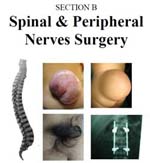Craniovertebral Junction Lesions and Single Stage Anterior Decompression Followed by Posterior Fusion
Keywords:
Craniocervical junction, Transoral decompression, Occipitocervical fixationAbstract
Objective: To asses the outcome of transoral microsurgical excision of anterior placed craniovertebral junction (CVJ) lesions excision followed by posterior craniocervical stabilization.
Study Design: Qausi Experimental study. Setting: Department of neurosurgery PINS/Lahore General Hospital, Lahore. from May 2017 to Aug 2018.
Inclusion Criteria: Male and Female patients of 12-65 yrs of age with compressive lesion at the ventral aspect of craniovertabral junction.
Exclusion Criteria: Lateral and posterolateral lesions, lesion below C2 vertebral body, patient unfit for anaesthesia and surgery. Material and Methods: 12 consecutive patients coming in OPD and emergency department of our unit and fulfilling the inclusion criteria were studied. All patients were prepared for the surgery and written informed consent taken from all our patients. The patients underwent anterior trans oral microsurgical excision of the tumour followed by posterior fixation.
Results: Out of 12 patients (range 12–65 years); Rheumatoid arthritis in 1 patient, tumor in 5 patients or trauma in 4 case and basilar invaginations in 2 patients. All my patients had headache (cranial and/or high-cervical pain), 73% of patients presented with quadriparesis, and 29% presented with basal cranial nerves involvements. Anterior decompression followed by posterior craniocervical fixations was done in all patients in same sitting. Out of 5 patients having severe neurological deficits preoperatively 3 improved. The remaining 7 patients have mild to moderate neurological deficits improved gradually throughout the follow-up periods to independent level. Among complications mortality in 1 patient and morbidity in the form of dural tear, CSF leak and infection in 2 patient). Craniocervical instability was seen in one patients after 3 months of surgery.
Conclusion: A good surgery with proper decompression at the craniovertebral junction is technically difficult procedure and demands expertise. It needs proper preoperative planning and investigations and adequate decompression and stabilization with proper implants.
References
2. Kandziora F Pflugmacher R Ludwig K Duda G Mittl-meier T Haas N P Biomechanical comparison of four anterior atlantoaxial plate systems. J Neurosurg. 2002; (96) 3, Suppl): 313–320.
3. Yin Q, Ai F, Zhang K. et al. Irreducible anterior atlan-toaxial dislocation: one-stage treatment with a trans-oralatlantoaxial reduction plate fixation and fusion. Report of 5 cases and review of the literature. Spine (Phila Pa 1976), 2005; 30 (13): E375–381.
4. Stulík J Vyskocil T Sebesta P Kryl J. Harms technique of C1-C2 fixation with polyaxial screws and rods[in Czech]. Acta Chir Orthop Traumatol Cech. 2005; 72: 122–27.
5. Hadley MN, Spetzler RF, Sonntag VKH. The transoral approach to the superior cervical spine. A review of 53 cases of extradural cervicomedullary compression. J Neurosurg. 1989; 71: 16–23.Doi: 10.3171/jns.1989.71.1.0016.
6-Pásztor E, Vajda J, Piffkó P, Horváth M, Gádor I. Transoral surgery for craniocervical space-occupying processes. J Neurosurg. 1984; 60: 276–281. Doi: 10.3171/jns.1984.60.2.0276.
7. Perrini P, Benedetto N, Di Lorenzo N. The transoral approaches to the craniovertebral junction malformat-ions: surgical strategies and results in a series of 34 consecutive patients. Neurosurgery, 2008.
8. Spetzler RF, Dickman CA, Sonntag VKH. The trans-oral app roach to the anterior cervical spine. Contemp Neurosurg. 1991; 13: 1–6.
9. Di Lorenzo N, Fortuna A, Guidetti B. Craniovertebral junction malformations. Clinicoradiological findings, long-term results and surgical indications in 63 cases. J Neurosurg. 1982; 57: 603–608.
Doi: 10.3171/jns.1982.57.5.0603.
10. Kassam A, Abla A, Snyderman C, Carrau R, Spiro R. An endoscopic transnasalodontoidectomy to treat cer-vicomedullary compression with basilar invagination. Oper Tech Neurosurg. 2005; 8: 198–204.
11. Messina A, Bruno M C, Decq P, et al. Pure endoscopic endonasalodontoidectomy: anatomical study. Neuro-surg Rev. 2007; 30: 189–194. Discussion 194.
12. Wolinsky J P, Sciubba D M, Suk I, Gokaslan Z L. Endoscopic image-guided odontoidectomy for decom-pression of basilar invagination via a standard anterior cervical approach: technical note. J Neurosurg Spine,
2007; 6: 184–191.
13. Di Lorenzo N. Craniocervical junction malformation treated by transoral approach. A survey of 25 cases with emphasis on postoperative instability and outcome. Acta Neurochir (Wien), 1992; 118 (11): 2–116.
14. Crockard HA, Calder I, Ransford AO. One-stage trans-oral decompression and posterior fixation in rheumatoid atlanto-axial subluxation. J Bone Joint Surg Br. 1990; 72: 682–685.
15. Al-Mefty O, Borba LA, Aoki N, Angtuaco E, Pait G. The transcondylar approach to extradural nonneoplastic lesions of the craniovertebral junction. J Neurosurg. 1996; 84: 1–6.
16. Balasingam V, Anderson GJ, Gross ND, Cheng CM, Noguchi A, Dogan A, McMenomey SO, Delashaw JB, Andersen PE. Anatomical analysis of transoral surgical approaches to the clivus. J Neurosurg. 2006; 105: 301–308. Doi: 10.3171/jns.2006.105.2.301.
17. Crockard HA. Transoral surgery some lessons learned. Br J Neurosurg. 1995; 9: 283–293.
Doi: 10.1080/02688699550041304.
18. Dickman CA, Locantro J, Fessler RG. The influence of odontoid resection on stability of the craniovertebral junction. J Neurosurg. 1992; 77: 525–530.
Doi: 10.3171/jns.1992.77.4.0525.
19. Naderi S, Crawford NR, Melton MS, Sonntag VK, Dickman CA. Biomechanical analysis of cranial sett-ling after transoral odontoidectomy. Neurosurg Focus, 1999; 6 (6): Article 7.

Downloads
Published
Issue
Section
License
The work published by PJNS is licensed under a Creative Commons Attribution-NonCommercial 4.0 International (CC BY-NC 4.0). Copyrights on any open access article published by Pakistan Journal of Neurological Surgery are retained by the author(s).












